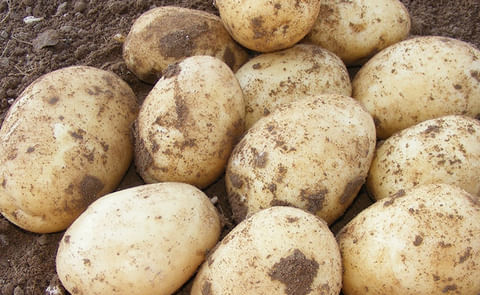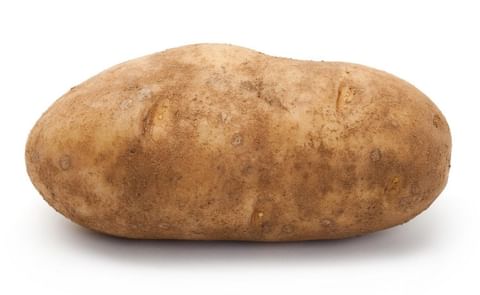Extreme weather events (Heat and Drought Stress) pose a significant challenge to potato cultivation.
Heat and Drought stress in potatoes: is it possible to prevent damage?
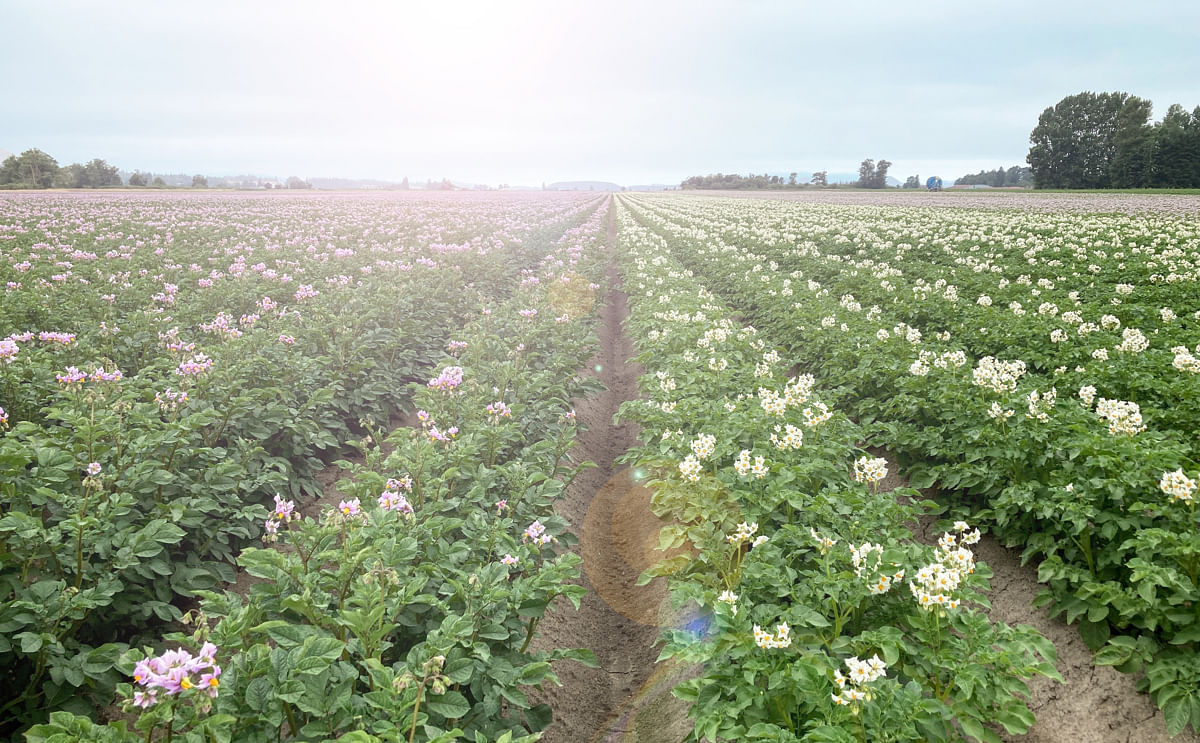
Extreme weather events pose a significant challenge to potato cultivation. Heat an drought stress reduces productivity, causes physiological defects in tubers, and damages crops. However, recent studies have shown that natural technologies containing plant hormones and betaines might be able to mitigate or control potato plants' response to heat stress.
In the United Kingdom the top 10 warmest years since 1884 have occurred in the last 2 decades. The highest temperature ever recorded in the UK is 40.3°C, set in Lincolnshire on 19th July last year, and on the same day 35°C was exceeded for the first time in Scotland. And whilst multiple records were broken in 2022, the Met Office is forecasting 2023 to be hotter still.
Drought and heat stress are problematic in potato cultivation as modern varieties are adapted to grow at temperatures between 14°C and 22°C. Potato productivity is reduced at higher temperatures, typically whenever 25°C is exceeded during the day.
 How Heat Affects Potato Yields.
How Heat Affects Potato Yields.
Potato plants under abiotic stress conditions suffer a disturbance in normal hormonal regulation, plant metabolism and photosynthesis. Reactive oxygen species (ROS) are generated and these cause membrane damage and cell death.
As a consequence the rate of photosynthesis is reduced, the movement of assimilates from the leaves to the developing tubers is disrupted, and biomass accumulation is compromised.
The result is inhibition of tuberisation, secondary tuberisation - also called secondary growth - , reduction in tuber bulking and ultimately loss of yield. Heat stress also causes physiological defects such as early skin set which is often followed by skin cracking and a loss of tuber quality.
The earlier a heat wave occurs, and the longer it lasts, the more negative its impact. However, there are natural technologies which can minimise these losses to heat stress.
Lincolnshire Trial
During 2022 independent, scientific trials were conducted in maincrop potato cv. 'Melody', a partially determinate variety, in Lincolnshire on loamy coastal soil. The trial was not irrigated.
The treatment was a simple programme of in-furrow application using a high-quality seaweed based biostimulant, CS1, followed by 6 low volume foliar sprays of the same product at regular intervals throughout the life of the crop.
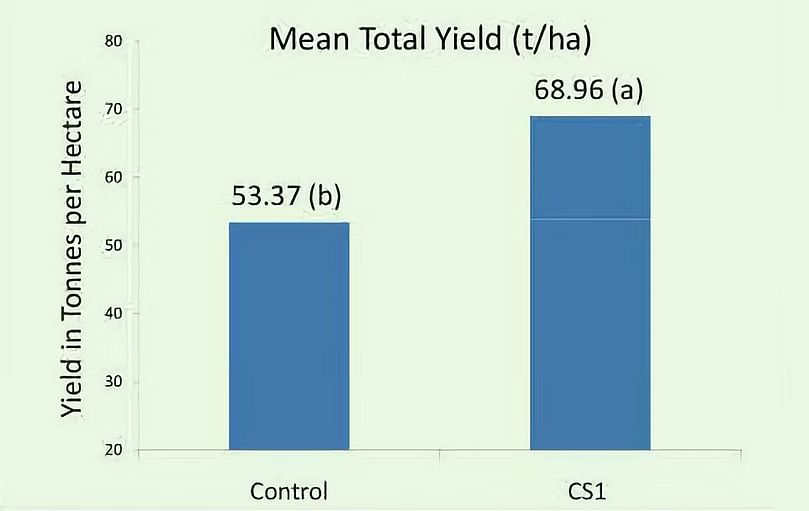 The 2022 growing season in the UK experienced 3 heat waves, one in each month of June, July and August, which were crucial tuber formation and bulking periods for this crop. However, the impact of the prolonged heat stress was reduced in the treated plants.
The 2022 growing season in the UK experienced 3 heat waves, one in each month of June, July and August, which were crucial tuber formation and bulking periods for this crop. However, the impact of the prolonged heat stress was reduced in the treated plants.
Norfolk Trial
A further trial with CS1 as one of the treatments in Norfolk with Russet Burbank, an indeterminate variety, showed a yield increase of 40%. In this case, the trial was on free-draining loamy soil and was irrigated.
In this trial, CS1 foliar sprays were combined with other bio-stimulants, including a microbial treatment. There is evidence to suggest that using a range of bio-stimulants can be more effective than a single product application programme.
Leaf Assessment
In an interim assessment of the foliage the treated plants appeared darker and denser than the untreated plants.
 This suggests a higher leaf area index and an increased level of chlorophyll in the leaves of the treated plants. Numerous studies have demonstrated increased photosynthetic activity following seaweed extract foliar application.
This suggests a higher leaf area index and an increased level of chlorophyll in the leaves of the treated plants. Numerous studies have demonstrated increased photosynthetic activity following seaweed extract foliar application.
Root Assessment
Interim investigation of the roots revealed that the untreated plants were at the hook stage, but the treated plants were beginning to form small tubers.
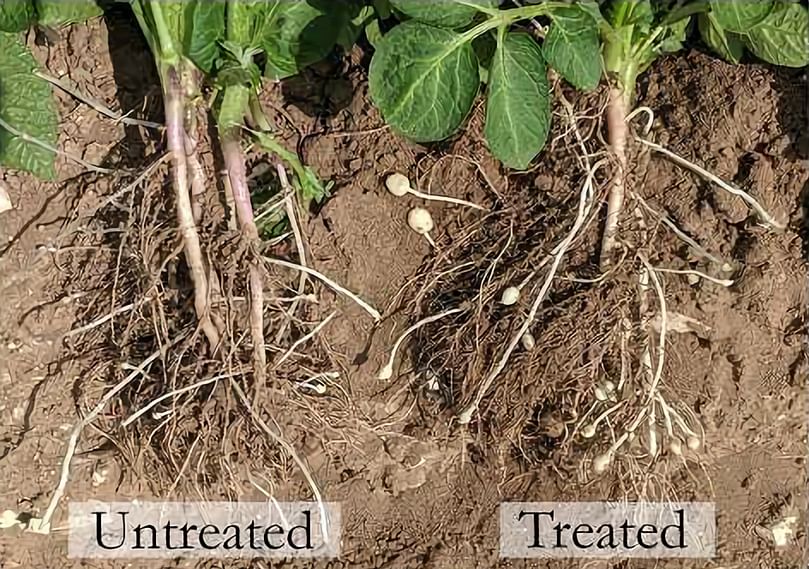 This suggests that the treatment had advanced the physiological stage of the crop. In theory, this should lead to the development of more tubers that are larger and heavier as tuber development will occur over a longer period in the crop cycle. This was confirmed at harvest.
This suggests that the treatment had advanced the physiological stage of the crop. In theory, this should lead to the development of more tubers that are larger and heavier as tuber development will occur over a longer period in the crop cycle. This was confirmed at harvest.
Biomass Assessment
Immediately prior to harvest soil samples from the untreated and treated plots were taken and sent to an independent laboratory to investigate differences in soil biomass. Increases in moisture content, bacteria and fungi were observed.
 Skin Assessment
Skin Assessment
A clear improvement in skin finish was observed where 43% of the untreated control was affected by black scurf (Rhizoctonia solani), but only 6% of the treated crop showed any symptoms. The irregular black/brown masses on the surface of the tuber are the sclerotic, or resting bodies, of the disease.
They are superficial and do not affect the tuber quality however, they do perpetuate the disease and inhibit plant establishment from the tuber if used as seed.
Tuber Assessment
A visual comparison was made with the final tubers at harvest and a clear difference was apparent. In line with the interim root assessment the treated plants delivered a higher number of heavier and larger tubers. The majority of the tuber increase was seen in the mid-range.
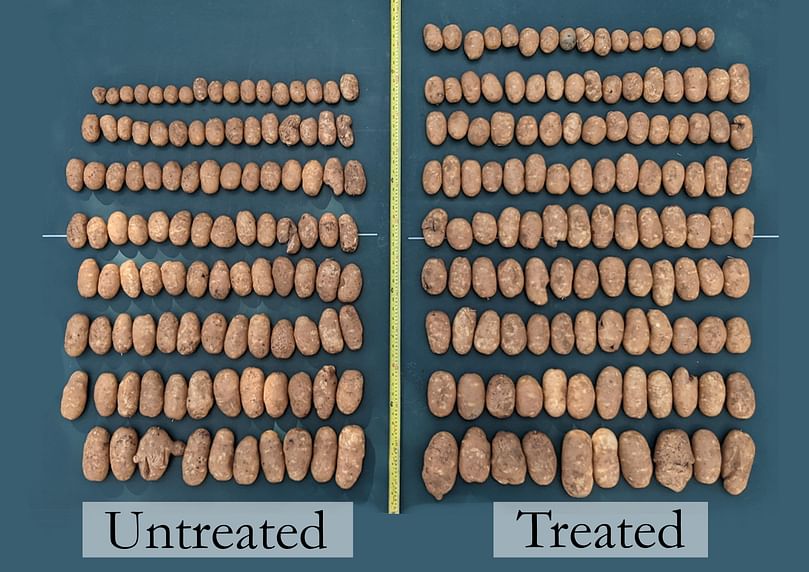 Final Results
Final Results
In this trial, the application of beneficial microbes, plus regular applications of CS l resulted in an increase in yield in maincrop potatoes. A highly significant yield increase of 40% was observed.
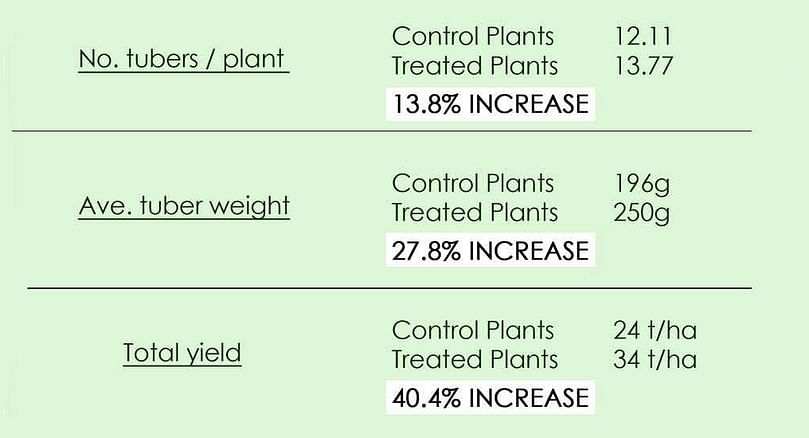 As with all field trials, these results were influenced by local climatic conditions and the biological, physical and chemical condition of the soil, meaning that results will differ from trial to trial. Soil-plant-climate interactions are complex.
As with all field trials, these results were influenced by local climatic conditions and the biological, physical and chemical condition of the soil, meaning that results will differ from trial to trial. Soil-plant-climate interactions are complex.
A deeper understanding of the effects of bio stimulants on all aspects of the ecosystem is required in order to improve future methodologies in sustainable food production. However, these results, from heat stressed trials in Lincolnshire and Norfolk in 2022 strongly suggest that seaweed-based bio stimulants can help reduce potato yield losses due to abiotic stress and can improve crop quality.
As the frequency and magnitude of heat stress episodes intensify due to global climate change, we need to adapt. Understanding and implementing effective methods to mitigate stressful growing conditions is now a priority for farmers and growers, not just in the United Kingdom, but around the world.
In the United Kingdom the top 10 warmest years since 1884 have occurred in the last 2 decades. The highest temperature ever recorded in the UK is 40.3°C, set in Lincolnshire on 19th July last year, and on the same day 35°C was exceeded for the first time in Scotland. And whilst multiple records were broken in 2022, the Met Office is forecasting 2023 to be hotter still.
Drought and heat stress are problematic in potato cultivation as modern varieties are adapted to grow at temperatures between 14°C and 22°C. Potato productivity is reduced at higher temperatures, typically whenever 25°C is exceeded during the day.

How Heat Affects Potato Yields
Potato plants under abiotic stress conditions suffer a disturbance in normal hormonal regulation, plant metabolism and photosynthesis. Reactive oxygen species (ROS) are generated and these cause membrane damage and cell death.
As a consequence the rate of photosynthesis is reduced, the movement of assimilates from the leaves to the developing tubers is disrupted, and biomass accumulation is compromised.
The result is inhibition of tuberisation, secondary tuberisation - also called secondary growth - , reduction in tuber bulking and ultimately loss of yield. Heat stress also causes physiological defects such as early skin set which is often followed by skin cracking and a loss of tuber quality.
The earlier a heat wave occurs, and the longer it lasts, the more negative its impact. However, there are natural technologies which can minimise these losses to heat stress.
Lincolnshire Trial
During 2022 independent, scientific trials were conducted in maincrop potato cv. 'Melody', a partially determinate variety, in Lincolnshire on loamy coastal soil. The trial was not irrigated.
The treatment was a simple programme of in-furrow application using a high-quality seaweed based biostimulant, CS1, followed by 6 low volume foliar sprays of the same product at regular intervals throughout the life of the crop.

Lincolnshire Trial: Yield for the treated potatoes was 29.2% higher than the control, equivalent to an extra 15 tonnes per hectare.
Norfolk Trial
A further trial with CS1 as one of the treatments in Norfolk with Russet Burbank, an indeterminate variety, showed a yield increase of 40%. In this case, the trial was on free-draining loamy soil and was irrigated.
In this trial, CS1 foliar sprays were combined with other bio-stimulants, including a microbial treatment. There is evidence to suggest that using a range of bio-stimulants can be more effective than a single product application programme.
Leaf Assessment
In an interim assessment of the foliage the treated plants appeared darker and denser than the untreated plants.

Leaf Assessment
Root Assessment
Interim investigation of the roots revealed that the untreated plants were at the hook stage, but the treated plants were beginning to form small tubers.

Root Assessment
Biomass Assessment
Immediately prior to harvest soil samples from the untreated and treated plots were taken and sent to an independent laboratory to investigate differences in soil biomass. Increases in moisture content, bacteria and fungi were observed.

Biomass Assessment
A clear improvement in skin finish was observed where 43% of the untreated control was affected by black scurf (Rhizoctonia solani), but only 6% of the treated crop showed any symptoms. The irregular black/brown masses on the surface of the tuber are the sclerotic, or resting bodies, of the disease.
They are superficial and do not affect the tuber quality however, they do perpetuate the disease and inhibit plant establishment from the tuber if used as seed.
Tuber Assessment
A visual comparison was made with the final tubers at harvest and a clear difference was apparent. In line with the interim root assessment the treated plants delivered a higher number of heavier and larger tubers. The majority of the tuber increase was seen in the mid-range.

Tuber Assessment
In this trial, the application of beneficial microbes, plus regular applications of CS l resulted in an increase in yield in maincrop potatoes. A highly significant yield increase of 40% was observed.

Conclusions
A deeper understanding of the effects of bio stimulants on all aspects of the ecosystem is required in order to improve future methodologies in sustainable food production. However, these results, from heat stressed trials in Lincolnshire and Norfolk in 2022 strongly suggest that seaweed-based bio stimulants can help reduce potato yield losses due to abiotic stress and can improve crop quality.
As the frequency and magnitude of heat stress episodes intensify due to global climate change, we need to adapt. Understanding and implementing effective methods to mitigate stressful growing conditions is now a priority for farmers and growers, not just in the United Kingdom, but around the world.
Like to receive news like this by email? Join and Subscribe!
Get the latest potato industry news straight to your WhatsApp. Join the PotatoPro WhatsApp Community!
Highlighted Company
Potato varieties mentioned
Sponsored Content
Sponsored Content
Sponsored Content
Sponsored Content


